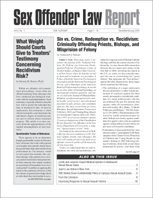U.S. Supreme Court Holds That Mandatory Prison Treatment Program Requiring Admission of Guilt Does Not Violate Convicted Sex Offender’s Constitutional Rights
Author: Roslyn Myers, Esq..
Source: Volume 03, Number 05, August/September 2002 , pp.67-68(2)

< previous article |next article > |return to table of contents
Abstract:
In McKune v. Lile, 122 S.Ct. 2017 (2002), which was argued by SLR board member Steven R. McAllister, the U.S. Supreme Court yet again considered the constitutionality of a sex offender inmate treatment program. Respondent Lile, a Kansas inmate who had been convicted of the rape, aggravated sodomy, and aggravated kidnapping of a high school student, was ordered by prison officials to participate in a Sexual Abuse Treatment Program (SATP) a few years before his scheduled release. The 18-month program entailed daily counseling sessions aimed to help inmates address their sexual propensities and understand the thoughts, feelings, and behavior dynamics that preceded their offenses. The overall goal was to instill in participants important relapse prevention skills so they are not a danger to society, when released. The SATP required inmates to admit responsibility for the crimes for which they have been sentenced and provide an extensive sexual history detailing all prior sexual activities, regardless of whether the activities constitute uncharged criminal offenses. A polygraph examination was used to verify the accuracy and completeness of the offender’s sexual history. Although there was no indication that in criminating information had ever been disclosed under the SATP, inmates are not granted immunity from future criminal proceedings based on these admissions. Also, Kansas law required SATP staff members to report any uncharged sexual offenses involving minors to law enforcement authorities.Keywords:
Affiliations:
.